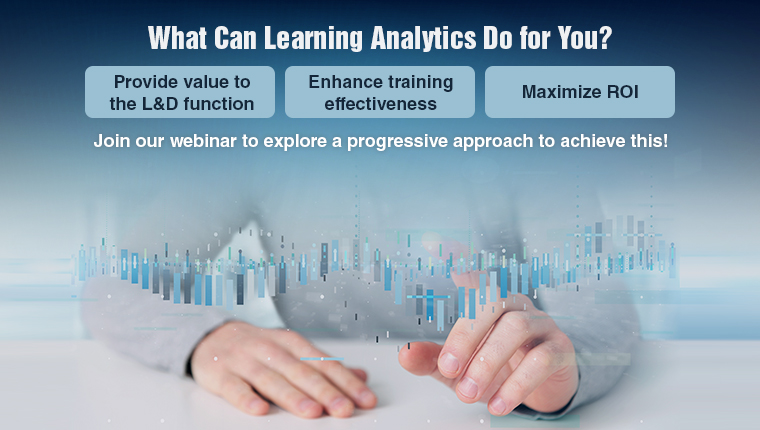Optimizing Training Budgets with Learning Analytics to Achieve Maximum ROI

Most modern organizations believe in the power of effective learning and training and would like to give their employees ample opportunities for learning and development. According to the 2019 Workplace Learning Report from LinkedIn, 94% of employees would stay at an organization longer if it invested in their learning and development. That leaves us with an important question! How much of training is actually enough? Can learning analytics help us answer this question and achieve maximum return on investment (ROI) on our training budget?
Improving ROI with Learning Analytics
Did you know that learning analytics can be used to optimize training budgets and improve the return on investment (ROI) of your training solution?
Using learning analytics, data on course completion, time spent on completion, assessment scores, and learner engagement can all be analyzed. Deeper learning analytics can provide better insights and adaptive guidance to drive efficiency and effectiveness. This helps optimize your training budget and achieve maximum ROI.
This blog would have been impossible without insights from a conversation we had with Dr. Howard Lewis, a Certified Performance Technologist who has also published a number of articles for professional organizations such as ATD and ISPI.
We’re all aware that a one-size-fits-all training approach no longer works. Consider the example of an online skill-based training program. If you’re teaching a new principle or process, and you want learners to practice or apply what they have learned in a simulated environment, for some learners one practice exercise might be enough whereas others might require more practice.
Forcing all learners to go through all practice exercises may not work well when your training solution aims to accelerate time to proficiency. How can we optimize training budgets when the requirements of individual learners are so different? Thankfully, learning analytics can give you insights into what works well, what doesn’t, and help maximize the efficiency of your training solutions.
Understanding the Importance of Learning Analytics
Let’s say you’re training employees on a 10-step procedure. The units or topics in the eLearning course along with the approximate time taken to take the learner through each unit is given below.
| Topic/Unit | Approximate Training Time |
| Inform participants about the new procedure | 5 min |
| Demonstrate and role model how to perform the procedure | 5 min |
| Opportunities to practice with coaching and feedback | 10 min |
| Assessment | 5 min |
| Total | 25 min |
To understand how learning analytics can make a difference and optimize ROI, we’ll take you through two different scenarios – the first scenario includes limited learning analytics and the second uses deeper measurements.
Scenario 1
In this scenario, different units in the eLearning course are bundled into a single learning experience and learners are required to go through all the units. Learning analytics are restricted to tracking:
- Number of learners who’ve completed the training, and
- Passing score on the final assessment.
|
Training Budget = |
The training budget is based on sample cost of developing the solution along with implementation across the target audience; essentially the same cost for each person. Here’s a hypothetical calculation to figure out the training cost for this course.
Assume that the organization has 1,000 participants who’ll be taking the online training. Let’s say the cost of training is $25 per person ($1 per minute per person and the duration of training is 25 minutes).
$25/person x 1,000 Participants = $25,000 Cost
Total training time = 25,000 minutes (417 hours)
The hypothetical calculation for Scenario 1 shows a training budget of $25,000 and a total training time of 417 hours.
While it may be possible to draw some conclusions from the overall completion rate of the course to show some ROI, this is not a very effective approach to demonstrate value.
Scenario 2
Now, let’s look at the second scenario where learners are allowed to choose what they need to learn. This is done by making effective use of learning analytics. While new hires might need to go through the complete training on the 10-step procedure, experienced employees might be able to apply existing knowledge and not need all units. In such cases, you can have learners take a pre-test to determine their existing knowledge and then be given the option to proceed to the practice exercise. If they complete one successfully, they get the option to take the next practice exercise or test out and complete the course.
By offering learners the flexibility to choose the topics and instructional elements that they’d like to complete, the time taken to complete the training differs for each learner. Using a common bell curve, let’s say 10% of the participants needed all 25 minutes, 80% needed 15 minutes and 10% needed only 10 minutes.

Now that the time taken to complete the training differs for each participant, the cost per participant also changes. When a learner takes less time to complete the training, productivity increases as time to proficiency is accelerated – per individual and across the organization as a whole. It also results in a saving on the training budget. Let’s see how there’s a saving in training budget as compared to Scenario 1.
| Number of Participants | Time Taken to
Complete Training |
Cost |
| 10% (100 people) | 25 min | $2500 |
| 80% (800 people) | 15 min | $12,000 |
| 10% (100 people) | 10 min | $1000 |
In scenario 2, the total cost of training is $15,500.
Total training time = 15,500 minutes (238 hours)
Inference from Scenarios 1 and 2
Scenario 1 resulted in a training expenditure of $25,000 and a total training time of 417 hours whereas Scenario 2 resulted in a training expenditure of $15,500 and a total training time of 238 hours.
By effectively using learning analytics, there’s been a saving of $9,500 and the total training time has been cut down by almost half – a whopping saving of 179 hours. Scenario 2 that makes use of learning analytics is definitely more efficient and effective than Scenario 1. Scenario 2 is a good example of optimizing training budgets and maximizing ROI.
How Does a Deeper Level of Learning Analytics Help?
When learning analytics are limited to completions and passing scores, you don’t get much insight into what is happening with your solutions and learners. On the other hand, when you design for (unbundled) and implement learning analytics at a deeper level you get answers to crucial questions such as:
- Which elements were used? By whom?
- How many attempts? How much time?
- What elements were used when the final assessment was successfully completed/not completed?
- How many learners liked or recommended the course?
Based on your analysis, you’ll have data to take informed decisions associated with improving your training solutions, not to mention the instant improvement in ROI.
Conclusion
Deeper learning analytics can provide better insights and adaptive guidance to drive efficiency and effectiveness. This in turn helps you optimize your training budget and achieve maximum ROI.
Perhaps it’s time you took a look at the metrics that are measured in your current training programs and then consider making use of deeper analytics to get the maximum from minimum investment.




![The Roadmap for Implementing Learning Analytics [Infographic]](https://blog.commlabindia.com/hubfs/Imported_Blog_Media/learning-analytics-implementation-roadmap.jpg)
